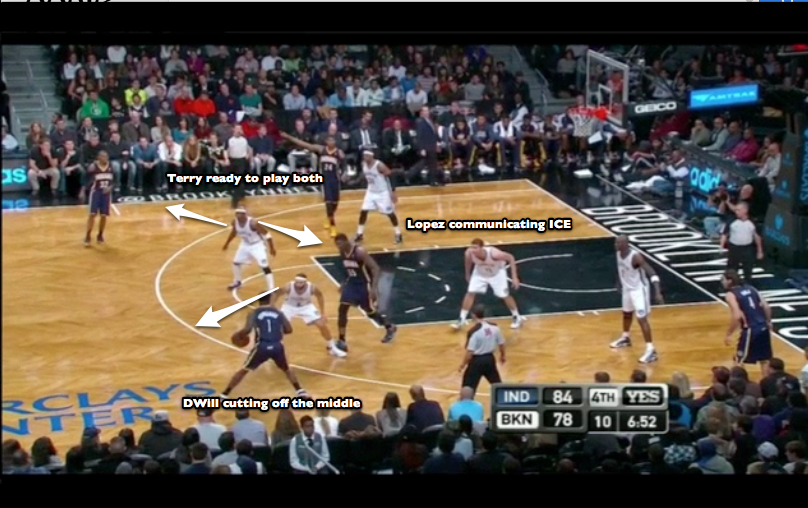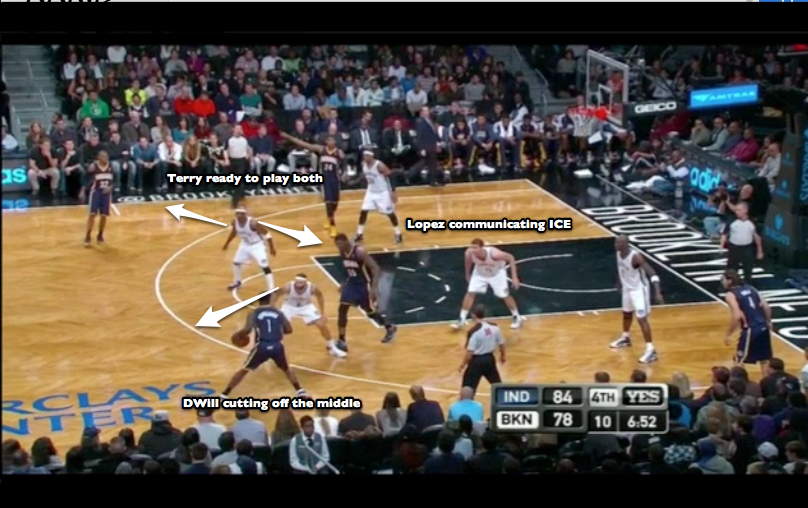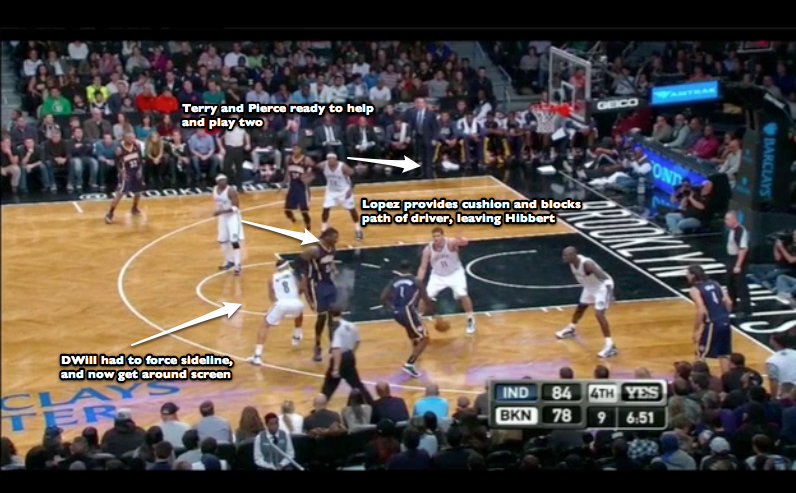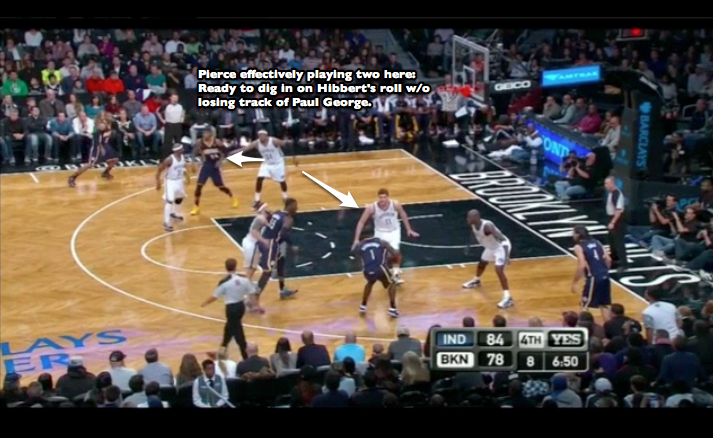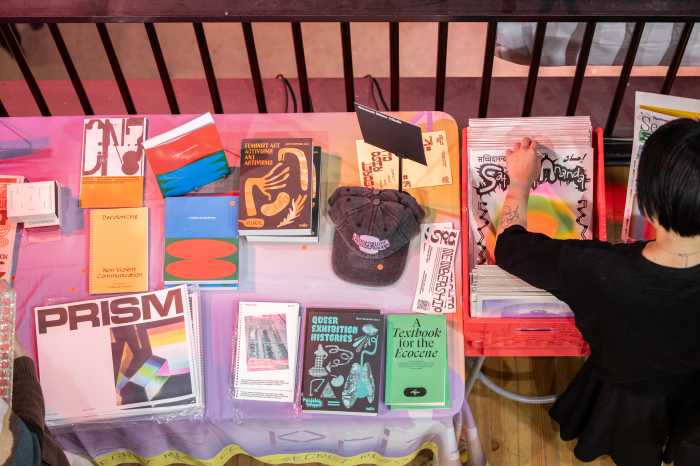This may look like just another play: Lance Stephenson misses a shot, and the Nets corral the rebound. But what’s involved in this play defensively is so much more, and it’s one of the major changes the Nets have made heading into this season.
As we pointed out earlier this season, the Nets have committing themselves to ICEing side pick–and-rolls, a defensive strategy championed by Jason Kidd and implemented with the help of assistant coach Lawrence Frank.
The great thing about ICEing (or “downing” – same concept, different language) is that it falls in line with one of the most basic defensive shell concepts: keep the ball out of the middle. Making a commitment to keeping the ball out of the middle of the floor, or the paint, pushes the offense out to lower-percentage areas of the floor and thus, theoretically, lowers its chance of scoring.
ICEing takes communication, coordination and smart helpside defense. As you’ll see, there is a concert of coordinated efforts that need to happen in succession for the strategy to work.
There are three elements of ICEing pick and rolls: the man defending the ball-handler, the man defending the screener and the weakside defenders.
On Ball Defender:
Every basketball coach across the globe operates under this most basic defensive tenet: “The person with the ball is the most dangerous offensive player.” That makes the person guarding the ball arguably the most important defensive player, and all great defenses start at the point of attack.
The person guarding the ball starts in a normal, hard stance, prepared to contain the ball and take away the middle. At the moment he hears the ICE call, his responsibility immediately shifts to “take away the middle of the floor and not allow the ball-handler to use the screen.” If either of those two things happen, the defense becomes entirely compromised and likely results in a bucket or a foul. To do this, the on ball defender needs to jump on the dribbler’s high side and begin influencing them towards the baseline.
In the below picture, you’ll notice the Nets setting up into ICE position, as Deron Williams jumps to the “high” side of Lance Stephenson, disallowing his dribble into the middle of the floor.
Person Guarding the Screener:
The screener guarding the ball has the most important job: calling out the coverage. In this case, it’s never too early to make that call. As soon as the defender recognizes his man is angling to set a screen, the defender needs to yell out ICE! ICE! to alert his guard that a) a screen is coming and b) he needs to adjust to ICE positioning.
Once the call is made, the screener’s defender needs to get in between the ballhandler and the basket (or, as a coach would say, “ball-you-basket”, nearer to the baseline where the guard on the ball influences the dribbler to go. If everyone does their job correctly, it forces the ball-handler to the baseline in a 1 vs. 2 situation.
Though the coverage is somewhat dependent on offensive personnel — corralling Cleveland Cavaliers superstar Kyrie Irving is a much different task than, say, Indiana Pacers guard George Hill — How close the big gets to the screening action or how close they stay home at the rim is predominantly dependent on personnel.
The Nets’ frontcourt offers an interesting dichotomy.
Brook Lopez, a huge, earth-eating big who lacks great mobility, is more of a “retreater”: staying home, providing lots of cushion but ready and able to contest everything at the rim. But Kevin Garnett — a more lithe, agile lengthy defender (well, in theory) can get closer to the screening action, perhaps trapping or jamming up the dribble as they make their move.
In the picture below, notice the positioning of Brook Lopez, who in this case was guarding screener Roy Hibbert. As soon as the Nets assumed their ICE coverage, Brook abandoned Hibbert and moved to a cushioned position on the baseline.
In this case, due to the Pacers’ poor spacing, Lopez is aided by Garnett, but Lopez also does a good job staying in the driving lane and discouraging Stephenson from going in that direction.
Helpside Defenders
AKA everybody else. Because ICE coverage basically sends two players to directly guard the ball, everyone else on the weak side of the defense is left in a vulnerable 3-on-4 situation. The three defenders left over have to make multiple snap decisions, each of which contributes vitally to the success or failure of the possession.
Because of this down numbers situation, the three helpside defenders are asked to play two players at once, so “stunting” (bringing pressure) towards the screener, and then stunting for the stunter, is one way to handle this. Regardless of the rotations, the helpside defenders need to load up heavily on the ball side of the court, giving up only a cross-court skip pass to the offense’s release valve.
The helpside defenders (Paul Pierce and Jason Terry) are faced with a dilemma on this possession. Since Hibbert is not much of a threat to pop, getting out to the perimeter is not as necessary, but digging in on Hibbert’s role is crucial.
Pierce does this beautifully, as he is able to provide just enough help on Hibbert’s role, while still remaining uber-conscious of Paul George in all his awesomeness.
It’s early in the season, and the Nets are still ironing out the rotations, so expect improvement on this defense as the year moves on. But even after a rehaul of the defensive system, they’ve made progress. Pick-and-roll ballhandlers are only shooting 38% vs. the Nets this year, according to mySynergySports. That’s a very workable number especially given the amount of pick and rolls the Nets will face this season.

